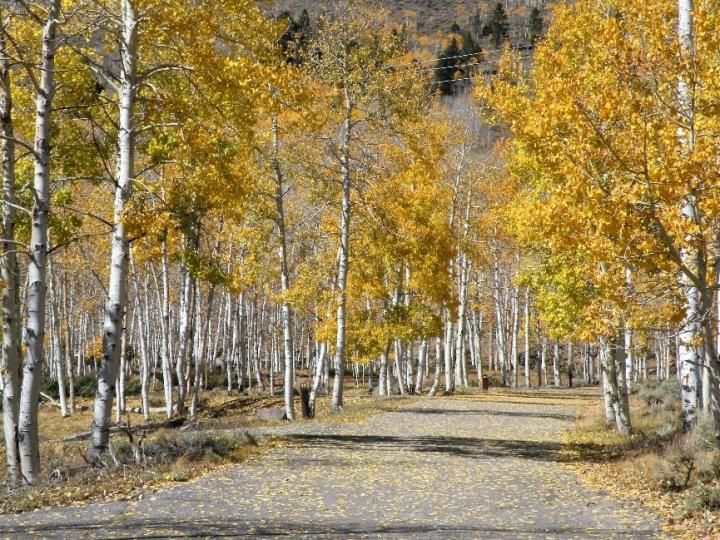
The Pando aspen clone in south-central Utah is widely considered to be the world's largest single organism, weighing an estimated 13 million pounds and covering some 106 acres (43 hectares) of the Fishlake National Forest. Also known as the Trembling Giant, Pando consists of more than 47,000 genetically identical quaking aspen trees which all originate from a single parent clone and are connected through an underground root system.
But all is not well with this unique "forest of one tree." Researchers Paul Rogers and Darren McAvoy from Utah State University have conducted the first complete assessment of conditions at Pando (Latin for "I spread") finding that much of the forest is deteriorating at an alarming rate, according to a study published in the journal PLOS ONE.
"We were interested in looking at Pando because visually it appeared there was little regeneration taking place, or at least surviving," Rogers told Newsweek. "Several years ago we—along with several collaborators—realized that this lack of new stems was a problem, particularly since the mature trees were beginning to die at a rapid pace."
Though the exact reasons are unknown, a combination of factors including human development, fire suppression activities, extended drought and, most importantly, grazing by deer (and to a lesser extent, cattle), are thought to be playing a role in the shrinking of the forest.
"[The threats], chiefly, [are] too many browsing animals for the current situation," Rogers said. "We knew Pando was doing poorly, but this study puts much more detail into that characterization."
Furthermore the study also found that current forest management practices, such as fencing designed to keep deer out, appear to be failing in many places, while about half of the area remains unprotected.
"After significant investment in protecting the iconic Pando clone, we were disappointed in this result," Rogers said in a statement. "In particular, mule deer appear to be finding ways to enter through weak points in the fence or by jumping over the eight-foot barrier."
For the study, the researchers monitored various areas in the forest to assess its health by measuring live and dead mature trees, stem regeneration, shrub cover and the number of deer droppings (as an indicator of their presence), among other observations.
They found that the presence of the mule deer severely affected the successful regeneration of the aspen trees. This decline in the replacement of trees is thought to have begun around 40 years ago. Nevertheless, the team did uncover one piece of good news—one portion of the forest is recovering nicely as a result of previous restoration efforts.
In the paper, the team included a set of photos stretching back 72 years, which chronicle the steady thinning of the forest and the continual intrusion of human development.
"The aerial photo sequence qualitatively illustrates a downturn in reproduction beginning approximately 40-50 years ago," Rogers said. "In addition to browsing, other impacts include a set of 30-year-old clear-cuts that never grew back because of the browsing, too. Added recreational facilities—homes, cabins, roads—also have an impact in that they create a de facto safe space for deer in regards to hunting."
"Hunters are not allowed to kill animals near such human activities for safety reasons," he said. "The deer really do learn that quickly and, therefore, deer populations are higher than surrounding areas and those deer do not have to move as much to avoid hunters. All of this adds up to concentrated browsing and elimination of future aspen generations setting up a situation where all of the mature trees are nearing the end of their natural lives and there are no replacement trees to fill in for the dying."
Taken together, the evidence suggests that Pando is failing and human decisions about wildlife, cattle and forest management are responsible, the authors say. In addition, the study also highlights the importance of aspen forests, which are commonly found across the northern hemisphere.
"In addition to ecological values, Pando serves as a symbol of nature-human connectedness and a harbinger of broader species losses," Rogers said.
"Here, regionally, and indeed internationally, aspen forests support great biodiversity. It would be a shame to witness the significant reduction of this iconic forest when reversing this decline is realizable, should we demonstrate the will to do so."
According to Rogers, we must do a better job of managing wildlife and vegetation in a coordinated fashion.
"In the western U.S., states manage the animals, particularly so-called 'game species,' and the federal government manages large forest reserves," he said. "These entities often have different priorities. In the case of Pando, mule deer management is somewhat in conflict with quaking aspen stewardship."
The authors suggest that forest managers will need to consider altering deer and cattle browsing patterns in the long term and shoring up fencing in the immediate term.
"Pando has a bleak future unless we focus some restoration attention on this iconic very large organism," Rogers said. "From a broader perspective, Pando is a reflection on how humans engage our world. The clone has been here for a very long time—we do not know the exact age, but likely thousands of years—and suddenly it is collapsing within one or two human generations. If we cannot save this 'forest of one tree' that is 106 acres in size, what does that say about ability to live sustainably on this planet?"
This article has been updated to include additional comments from Paul Rogers.
Uncommon Knowledge
Newsweek is committed to challenging conventional wisdom and finding connections in the search for common ground.
Newsweek is committed to challenging conventional wisdom and finding connections in the search for common ground.
About the writer
Aristos is a Newsweek science reporter with the London, U.K., bureau. He reports on science and health topics, including; animal, ... Read more
To read how Newsweek uses AI as a newsroom tool, Click here.








